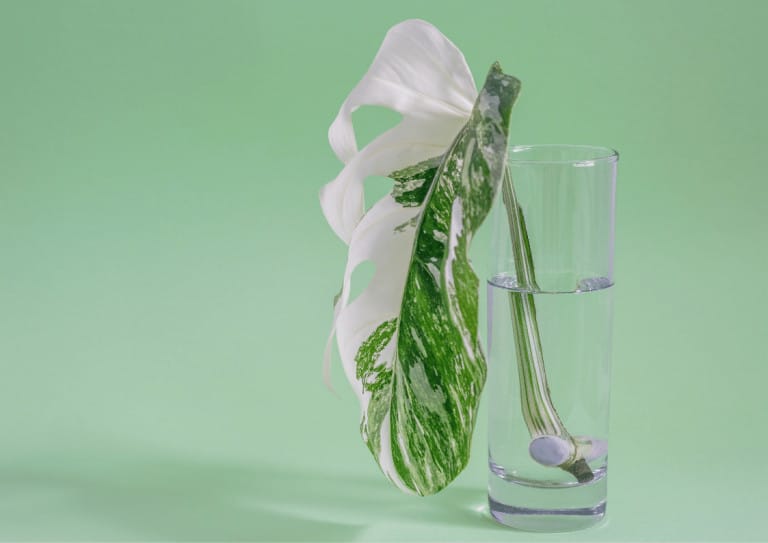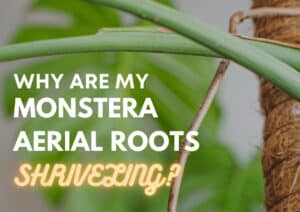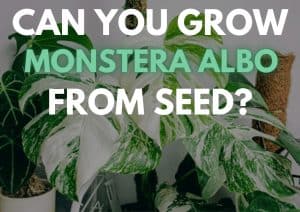Is It Possible To Graft Monstera? (Aroid Propagation)
- Lakeisha Ethans
- March 17, 2022
If you buy something using the retail links in our articles, sometimes we earn a small affiliate commission. This does not impact the products we recommend.
One popular propagation method is grafting, which involves taking a growing part of a plant, such as fruit, leaf, flower, or stem, and joining it with a root system of another plant. The former is called the scion and the latter is known as the rootstock. This practice allows people to essentially join two different plants together, with the purpose of expressing the traits of the scion.
But does this method work for Monstera plants? Can those who want to multiply a variegated scion take advantage of standard Monstera rootstock to promote the growth of a much desired leaf pattern?
The answer is yes, it is possible to graft Monstera (and other Ariods), with the greatest success observed when attaching the scion to rootstock of closely related species. This is one of the most common methods used to propagate rare and coveted variegated plants such as Monstera albo where the albo scions are grafted onto the strong rootstock of Monstera deliciosa.
If you do want to graft Monstera plants however, you must be mindful that creating the right environment is crucial to facilitating successful growth. After all, grafting as a form of aroid propagation can be difficult, and its complexities mean that you’re not always guaranteed success.
In this article, we aim to help you successfully graft Monstera by covering some essential tips including:
- The principles of good grafting
- How you can promote successful Monstera grafts
This post will help you to better understand the nature of grafting and how you can improve your chances of propagation success with this method.

TLDR on Monstera grafting
Grafting is a common horticultural technique used upon thousands of plant species. It is frequently used by commercial growers as a method of asexual propagation, it’s less common among houseplant hobbyists, but it’s certainly a good way to propagate variegated properties – and far easier than trying to induce new variegation in houseplants.
A cutting is taken from the stem of one plant (this is known as a scion), before being pressed together with the lower plant part, or the rootstock. Their tissues then fuse to continue to grow together. The goal is for the scion to take perfectly so it seems like it’s just a natural part of the rootstock plant.
The tissues involved in sustaining the scion are called vascular cambium tissues. Typically, after a few weeks of being manually attached to one another the tissues “take” to each other and grow. Keeping the plant alive in this difficult period is central to the success of grafting.
There are a few different kinds of grafting. The most common is simply called stem grafting, which uses a shoot scion and a rootstock of a different plant. There is also bud grafting, where you use a dormant bud as a scion on a chosen rootstock. Shoot grafting with an attached leaf is the most common way to graft Monstera.
In some plants, grafting can promote stronger, healthier growth overall. The resulting plant may be hardier or sturdier, and growth may occur at a faster rate for that plant from then on.
Our Favorite Monstera Plants And Supplies On Etsy
How can I promote successful Monstera grafts?
Grafting can be a complex process with multiple factors influencing the outcome of success.
One of the main factors of a successful Monstera graft is the compatibility of the grafted scion with the chosen rootstock. The more genetically compatible these two parts are the better the results. Don’t be tempted to create and strange hybrid plants just because they might look cool.
Another factor to keep in mind is the maturity of the scion and robustness of the rootstock involved in the grafting process. Both must be at a stage where they are capable of producing the right wound response tissue – so neither should be immature.
Poor attachment of the scion can also introduce disease or cause excessive loss of moisture at the grafting site. Many of the tutorials online are based around grafting fruit trees or ornamental plants such as roses, but the principles remain the same when working with Monstera.
When you perform the grafting process, sanitize the tools you’ll be using beforehand. This will reduce the risk of infection that can damage or even kill your plant before it has the chance to grow at all.
Next, you must make sure to maintain a good temperature for your plant. Overly high temperatures can prevent wound response tissues from forming healthily. This may also cause premature budding which diverts the plant’s energy away from the point of inosculation (where the scion and rootstock join) and reduces long-term success.
It is also recommended that you perform the grafting at the right time of day. Early morning or dusk are both good times, as this is when water movement through plant tissue is at its slowest, preventing too much water loss.
Finally, the exposed cells of the scion must be properly aligned with those of the rootstock. This is needed to allow healthy growth, a proper joining of tissue, and a correct flow of water and nutrients. Scientifically speaking, the vascular cambiums of both parts must be oriented to facilitate normal growth, as if the scion is naturally a part of the stock. They should also be pressed and held tightly together.
It goes without saying, but you should also expect to take extra care of the site where the grafting has occurred for several weeks after. The plant is “injured” and you need to nurse it to its full health so don’t cause it any undue stress by under/overwatering, excessive pruning or exposure to extreme temperatures.

Does Monstera variegation transfer through grafting?
The variegation displayed in a scion from Monstera albo or Monstera thai constellation will continue to be shown after being grafted to roost stock. It will not however cause foliage produced directly from the rootstock to convert to becoming variegated.
The success of grafting with a variegated scion is not a guaranteed, sure thing, but it works reliably enough to be used commercially.
Take home message
While strong, healthy donor plants will produce the best results, it’s a good idea to test your grafting skills on plants that you wouldn’t mind losing before diving straight into using valuable variegated Monstera scions.
This will let you learn, via trial and error, how to properly join scions to rootstock and care for the plant in the next weeks.
Grafting Monstera, especially for variegated foliage can be challenging – but it is possible.

Lakeisha Ethans
Houseplant Writer
Mother to two humans and hundreds of plant babies. Lakeisha uses her 15 years of experience as a content writer to specialise in simplifying what you need to know to grow and care for all indoor plants.
Similar Posts
Why Are My Monstera Aerial Roots Shriveling?
Should you be worried if the aerial roots on your Monstera starts shriveling up? Does this happen naturally or is it a sign of a poorly plant?
Can You Grow Monstera Albo From Seed?
The Monstera Albo is highly prized, but growing one is notoriously difficult. Can you successfully propagate them from seeds, or is that just a myth?



